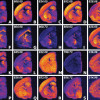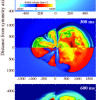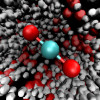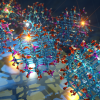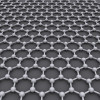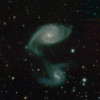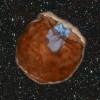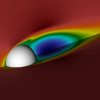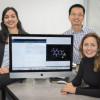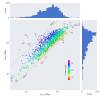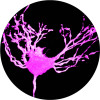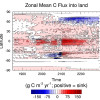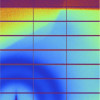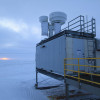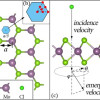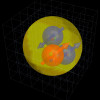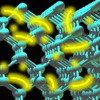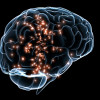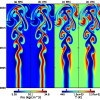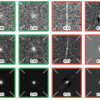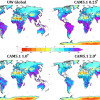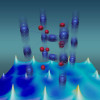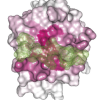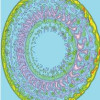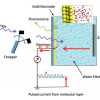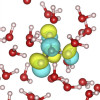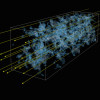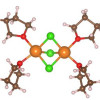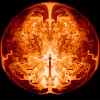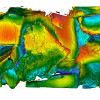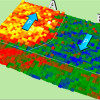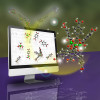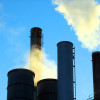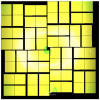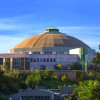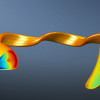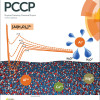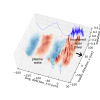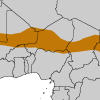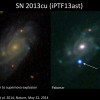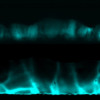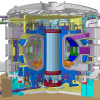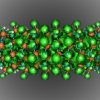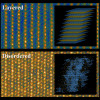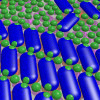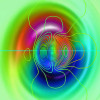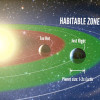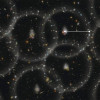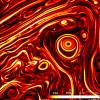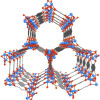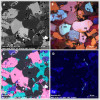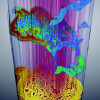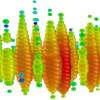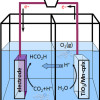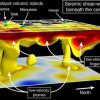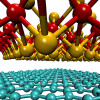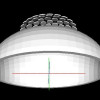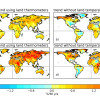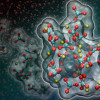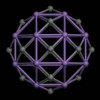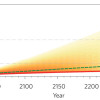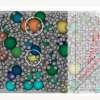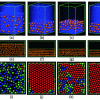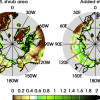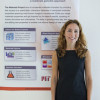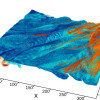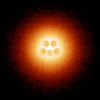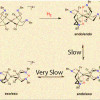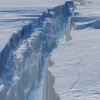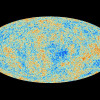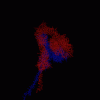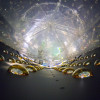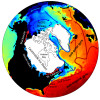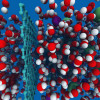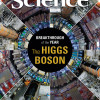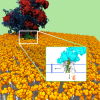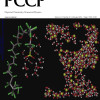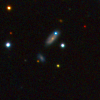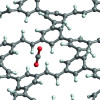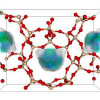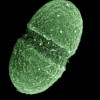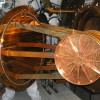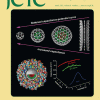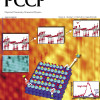Science News
‘Data Deluge’ Pushes Mass Spec Imaging to New Heights
Researchers at Berkeley Lab are working to help the scientific community address emerging data management and analysis issues through MANTISSA (Massive Acceleration New Techniques in Science with Scalable Algorithms), a DOE-funded program that supports the development of novel algorithms that will allow new software tools in a variety of science domains to run at scale on current and next-generation supercomputers. Read More »
The Rise and Fall of Core-Collapse Supernovae
A research team from Oak Ridge National Laboratory (ORNL), University of Tennessee, Florida Atlantic University and North Carolina State University compared 3D models run at ORNL with 2D models run at NERSC to shed new light on the explosion mechanism behind core-collapse supernovae. Read More »
Unravelling the Mysteries of Carbonic Acid
Blink your eyes and it’s long gone. Carbonic acid exists for only a tiny fraction of a second when carbon dioxide gas dissolves in water before changing into a mix of protons and bicarbonate anions. Despite its short life, however, carbonic acid imparts a lasting impact on Earth’s atmosphere and geology, as well as on the human body. However, because of its short lifespan, the detailed chemistry of carbonic acid has long been veiled in mystery. Researchers with Berkeley Lab and the Univ. of… Read More »
What the Blank Makes Quantum Dots Blink?
Quantum dots (shown here dissolved in liquid under ultraviolet light) offer tantalizing prospects for new technologies if scientists can stop them blinking. (Photo by Antipoff, CC BY-SA 3.0) Quantum dots are nanoparticles of semiconductor that can be tuned to glow in a rainbow of colors. Since their discovery in the 1980s, these remarkable nanoparticles have held out tantalizing prospects for all kinds of new technologies, ranging from paint-on lighting materials and solar cells to quantum… Read More »
Spiraling Laser Pulses Could Change Nature of Graphene
A new study that involved large-scale simulations run at NERSC predicts that researchers could use spiraling pulses of laser light to change the nature of graphene, turning it from a metal into an insulator and giving it other peculiar properties that might be used to encode information. Read More »
NERSC Hosts Digital Stargazing Portal
Even non-scientists can now browse sky survey images hosted at NERSC. The DECam Legacy Survey has published the first in a series of web-based catalogs that will offer an update to images of the night sky originally taken with the 15-year-old camera of the Sloan Digital Sky Survey. In the spirit of the new information age, the survey will share frequent updates on its public website. Read More »
Meraculous: Deciphering the ‘Book of Life’ With Supercomputers
A team of scientists from Berkeley Lab, JGI and UC Berkeley, simplified and sped up genome assembly, reducing a months-long process to mere minutes. This was primarily achieved by “parallelizing” the code to harness the processing power of supercomputers, such as NERSC’s Edison system. Read More »
Supernova Hunting with Supercomputers
Using a “roadmap” of theoretical calculations and supercomputer simulations performed at NERSC by Berkeley Lab’s Daniel Kasen, astronomers observed for the first time a flash of light caused by a supernova slamming into a nearby star, allowing them to determine the stellar system from which the supernova was born. This finding confirms one of two competing theories about the birth of Type Ia supernovae. Read More »
Chombo-Crunch Sinks Its Teeth into Fluid Dynamics
Berkeley Lab scientists are breaking new ground in the modeling of complex flows in energy and oil and gas applications, thanks to a computational fluid dynamics and transport code dubbed “Chombo-Crunch.” Read More »
Electrolyte Genome Could Be Battery Game-Changer
The Materials Project hosted at NERSC is taking some of the guesswork out of discovering new battery catalysts with the Electrolyte Genome. Read More »
Expanding the World’s Largest Database of Elastic Properties
Berkeley Lab scientists, using the infrastructure of the Materials Project and NERSC supercomputing resources, have calculated the complete elastic properties for 1,181 inorganic compounds. Read More »
BigNeuron: Unlocking the Secrets of the Human Brain
To find a standard 3D neuron reconstruction algorithm, BigNeuron will sponsor a series of international hackathons and workshops where contending algorithms will be ported onto a common software platform to analyze neuronal physical structure using the same core dataset. All ported algorithms will be bench-tested at NERSC, ORNL and Human Brain Project supercomputing centers.
Read More »
In Climatic Tug of War, Carbon From Thawing Permafrost Wins
New computer simulations conducted at NERSC by Berkeley Lab scientists are the first to represent permafrost processes as well as the dynamics of carbon and nitrogen in the soil. Read More »
Organic Photovoltaics Experiments Showcase ‘Superfacility’ Concept
A collaborative effort linking the Advanced Light Source at Berkeley Lab with supercomputing resources at NERSC and the Oak Ridge Leadership Computing Facility via ESnet is yielding exciting results in organic photovoltaics research that could transform the way researchers use these facilities and improve scientific productivity in the process. Read More »
First Direct Observation of Carbon Dioxide’s Increasing Greenhouse Effect at Earth’s Surface
Researchers from Berkeley Lab have observed an increase in carbon dioxide’s (CO2) greenhouse effect at the Earth’s surface for the first time. They attributed this upward trend to rising CO2 levels from fossil fuel emissions. Read More »
New Algorithm Enables Faster Simulations of Ultrafast Processes
The algorithm opens the door for efficient real-time simulations of ultrafast processes and electron dynamics, such as excitation in photovoltaic materials and ultrafast demagnetization following an optical excitation. Read More »
What Makes Clouds Form, Grow and Die?
Until recently, computer models for simulating climate on a global scale relied on mathematical formulas to approximate how clouds were born and grew. The advent of more advanced computers has enabled researchers to explicitly simulate large-cloud systems instead of approximating them. Read More »
Pinpointing the Magnetic Moments of Nuclear Matter
Using NERSC's Edison supercomputer, a team of nuclear physicists has made a key discovery in its quest to shed light on the structure and behavior of subatomic particles. Read More »
Laser, Supercomputer Measure Speedy Electrons in Silicon
In silicon, electrons attached to atoms in the crystal lattice can be mobilized into the conduction band by light or voltage. UC Berkeley scientists used a laser to take snapshots of this very brief band-gap jump and timed it at 450 attoseconds. Read More »
A Standard for Neuroscience Data
BrainFormat, a neuroscience data standardization framework developed at Berkeley Lab, is a strong contender to contribute to a data format and storage standard for the neuroscience research community. In conjunction with this work, NERSC is also contributing to the CRCNS data-sharing portal, which will allow neuroscience researchers worldwide to easily share files without having to download any special software. Read More »
Berkeley Lab Particle Accelerator Sets World Record
Using one of the most powerful lasers in the world, Berkeley Lab researchers have accelerated subatomic particles to the highest energies ever recorded from a compact accelerator. Computer simulations run at NERSC allowed them to test the experimental setup before ever turning on the laser. Read More »
Optimized Algorithms Boost Combustion Research
Turbulent combustion simulations, which provide input to the design of more fuel-efficient combustion systems, have gotten their own efficiency boost, thanks to researchers from Berkeley Lab's Computational Research Division. Read More »
Berkeley Algorithms Help Researchers Understand Dark Energy
The process of identifying and tracking Type Ia supernovae requires scientists to scrupulously monitor the night sky for slight changes, a task that would be extremely tedious and time-consuming for the Dark Energy Survey (DES) without some novel computational tools developed at NERSC by researchers at Berkeley Lab and UC Berkeley. Read More »
Supercomputers Fuel Global High-Resolution Climate Models
Not long ago, it would have taken several years to run a high-resolution simulation on a global climate model. But using supercomputing resources at NERSC, Berkeley Lab climate scientist Michael Wehner was able to complete a run in just three months. Read More »
How Atomic Vibrations Transform Vanadium Dioxide
A team led by Oak Ridge National Laboratory has made an important advancement in understanding a classic transition-metal oxide, vanadium dioxide, by quantifying the thermodynamic forces driving the transformation. Read More »
Mathematical Models Shed New Light on Cancer Mutations
Using mathematical modeling methods traditionally considered the property of statistical physics and artificial intelligence, researchers at Harvard Medical School have developed a way to identify important cancer mutations. Read More »
Using Radio Waves to Control Fusion Plasma Density
Recent fusion experiments on the DIII-D tokamak at General Atomics and the Alcator C-Mod tokamak at MIT showed that beaming microwaves into the center of the plasma can be used to control the density in the center of the plasma. Read More »
Water and Gold: A Promising Mix for Future Batteries
For the first time, researchers at Lawrence Berkeley National Laboratory have observed the molecular structure of liquid water at a gold surface under different charging conditions, paving the way for future studies of electrochemical interfaces that exist in current and prototype batteries. Calculations run at NERSC helped them better understand the chemistry. Read More »
Probing the Surprising Secrets of Carbonic Acid
Berkeley Lab researchers used the Advanced Light Source and NERSC to gain valuable new insights into carbonic acid, with important implications for both geological and biological concerns. Read More »
Supercomputer Helps Model 3D Map of Adolescent Universe
Using extremely faint light from galaxies 10.8 billion light years away, scientists have created one of the most complete, three-dimensional maps of a slice of the adolescent universe—just 3 billion years after the Big Bang. Read More »
Dispelling a Misconception About Mg-Ion Batteries
A series of computer simulations run at NERSC has dispelled a long-standing misconception about magnesium-ions in the electrolyte that transports the ions between a battery’s electrodes. Read More »
Simulations Reveal Unusual Death for Ancient Stars
Those primordial stars—between 55,000 and 56,000 times the mass of our Sun, or solar masses—may have died unusually. In death, these objects—among the Universe’s first-generation of stars—would have exploded as supernovae and burned completely, leaving no remnant black hole behind. Read More »
Pore Models Track Reactions in Underground Carbon Capture
Using tailor-made software running on top-tier supercomputers, a Lawrence Berkeley National Laboratory team is creating microscopic pore-scale simulations that complement or push beyond laboratory findings. The models of microscopic underground pores could help scientists evaluate ways to store carbon dioxide produced by power plants, keeping it from contributing to global climate change. The models could be a first, says David Trebotich, the project’s principal investigator. “I’m not… Read More »
Interface Surprises May Motivate Novel Oxide Electronic Devices
A research team led by Oak Ridge National Laboratory has discovered that intrinsic electric fields can drive oxygen diffusion at interfaces in engineered thin films made of complex oxides. This may serve as a basis for design of new electronic devices utilizing both electrons and ions. Read More »
Mapping the March to Methodical Materials
Scientists at DOE’s Pacific Northwest National Laboratory have determined the individual reactions and the energy needed at each step to form the basic unit of a popular MOF. Read More »
New Catalyst Converts CO₂ to Fuel
Scientists from the University of Illinois at Chicago have synthesized a catalyst that improves their system for converting waste carbon dioxide into syngas, a precursor of gasoline and other energy-rich products. Read More »
Photon Speedway Puts Big Data In the Fast Lane
In experiments run at the Linac Coherent Light Source, scientists from Berkeley Lab and SLAC used NERSC and ESnet to more quickly achieve a breakthrough in photosynthesis research. Read More »
DOE Project Taps HPC for Next-Generation Climate Modeling
High performance computing will be used to develop and apply the most complete climate and Earth system model to address the most challenging and demanding climate change issues. Read More »
SPOT Suite Transforms Beamline Science
Most synchrotron light sources have been operating on a manual grab-and-go data management model, but a recent data deluge is quickly making this practice implausible. So scientists from the Advanced Light Source (ALS), CRD and NERSC teamed up to create SPOT Suite, and it is already transforming the way scientists run their experiments at the ALS. Read More »
Hot Plasma Partial to Bootstrap Current
Supercomputers at NERSC are helping plasma physicists “bootstrap” a potentially more affordable and sustainable fusion reaction. Read More »
‘Thirsty’ Metals Key to Longer Battery Lifetimes
Replacing lithium with other metals with multiple charges could greatly increase battery capacity. But first researchers need to understand how to keep multiply charged ions—ions that have gained or lost more than one electron—stable. Read More »
'Erratic' Lasers Pave Way for Tabletop Accelerators
Making a tabletop particle accelerator just got easier. A new study by researchers from Berkeley Lab shows that certain requirements to build an emerging type of small-area particle accelerator can be significantly relaxed. Read More »
Farming: A Climate Change Culprit
Increased agricultural activity is a rain taker, not a rain maker, according to computer simulations of African monsoon precipitation. This research offer new insights into how land-use change may affect regional rainfall. Read More »
Confirmed: Stellar Behemoth Self-Destructs in Type IIb Supernova
For the first time ever, astronomers have direct confirmation that a Wolf-Rayet star—sitting 360 million light years away in the Bootes constellation—died in a violent explosion known as a Type IIb supernova. Using the iPTF pipeline, researchers caught supernova SN 2013cu within hours of its explosion. These observations are providing valuable insights into the life and death of the progenitor Wolf-Rayet. These stars are interesting because they enrich galaxies with the heavy chemical elements that eventually become the building blocks for planets and life. Read More »
Atomic Switcheroo Explains Origins of Thin-Film Solar Cell Mystery
Scientists have known since the 1980s that treating cadmium-telluride (CdTe) solar cell materials with cadmium-chloride improves efficiency, but the underlying physics has remained a mystery until now. Combining electron microscopy with computer simulations run at the Department of Energy’s National Energy Research Scientific Computing Center (NERSC), researchers have put this decades long debate to rest. Read More »
Calming Plasma's Stormy Seas
Energy researchers continue to make headway in their quest to better understand what makes a fusion reaction “tick.” Read More »
Clocking the Early Universe's Expansion
By analyzing the light of distant quasars gathered by the Baryon Oscillation Spectroscopic Survey (BOSS), astronomers have made the most accurate calculation yet of the expansion rate of the young Universe. Their findings could help scientists discover the nature of dark energy, the mysterious, repulsive force that pervades our universe causing it to expand at an accelerating rate. Read More »
To Bridge LEDs' Green Gap, Scientists Think Small
Nanostructures half the breadth of a DNA strand could improve the efficiency of light emitting diodes (LEDs), especially in the “green gap,” a portion of the spectrum where LED efficiency plunges, simulations at NERSC have shown. Read More »
Human-induced climate change reduces chance of flooding in Okavango Delta
Researchers at the University of Cape Town, Berkeley Lab and the United Nations Development Programme have analyzed how human-induced climate change has affected recent flooding in an ecologically and geographically unique river basin in southern Africa—the Okavango River. Read More »
Disordered Materials Hold Promise for Better Batteries
A lot of research is being done to facilitate the use of lithium batteries in electronic devices. Using supercomputers at NERSC, researchers have found a new avenue for such research: the use of disordered materials, which had generally been considered unsuitable for batteries. Read More »
Decoding the Molecular Mysteries of Photosynthesis
Understanding the inner workings of photosynthesis is key to building new man-made energy resources. Simulations run on NERSC supercomputers are helping researchers do just that. Read More »
Taming Plasma Fusion Snakes
Controlled nuclear fusion has held the promise of a safe, clean, sustainable energy resource for decades. Now, with concerns over global climate change growing, the ability to produce a reliable carbon-free energy source has taken on new urgency. Read More »
Are Earths Rare? Perhaps Not
One out of every five sun-like stars in our Milky Way galaxy has an Earth-sized planet orbiting it in the Goldilocks zone—not too hot, not too cold—where surface temperatures should be compatible with liquid water, according to a statistical analysis of data from NASA’s Kepler spacecraft. Read More »
BOSS Measures the Universe to One-Percent Accuracy
The Baryon Oscillation Spectroscopic Survey announced that it has measured the scale of the universe’s structure to an accuracy of one percent. This and future measurements at this precision are the key to determining the nature of dark energy. Read More »
Supercomputers Capture Turbulence in the Solar Wind
With help from Berkeley Lab's visualization experts and NERSC supercomputers, astrophysicists can now study turbulence in unprecedented detail, and the results may hold clues about some of the processes that lead to destructive space weather events. Read More »
An Inside Look at a MOF in Action
A unique inside look at the electronic structure of a highly touted metal-organic framework (MOF) as it is adsorbing carbon dioxide gas should help in the design of new and improved MOFs for carbon capture and storage. Read More »
NERSC Supercomputers Help Reveal Secrets of Natural Gas Reserves
Supercomputers at the Department of Energy’s National Energy Research Supercomputing Center (NERSC) helped scientists at Oak Ridge National Laboratory (ORNL) study gas and oil deposits in shale and reveal structural information that could lead to more efficient extraction of gas and oil from shale. Read More »
Big Data Hits the Beamline
When scientists from around the world visit Dula Parkinson’s microtomography beamline at Lawrence Berkeley National Laboratory’s Advanced Light Source, they all want the same thing: scientifically illuminating X-ray views of matter. Unfortunately, many of them have left with debilitating data overload. Department of Energy scientists like Parkinson are collaborating with computational scientists and mathematicians on data-handling and analysis tools. Read More »
Searching for Cosmic Accelerators via IceCube
New results from IceCube, the neutrino observatory buried at the South Pole, may show the way to locating and identifying cosmic accelerators in our galaxy that are 40 million times more powerful than the Large Hadron Collider at CERN. Read More »
Greenhouse Gases into Gold
Environmentalists have long lamented the destructive effects of greenhouse gases, with carbon dioxide (CO2) often accused of being the primary instigator of global climate change. As a result, numerous efforts are under way to find ways to prevent, capture and sequester—perhaps even bury—CO2 emissions and reduce their negative effects. But some researchers say CO2 is getting a bad rap. Read More »
New Model of Earth’s Interior Reveals Clues to Hotspot Volcanoes
Using supercomputers at NERSC, scientists have detected previously unknown channels of slow-moving seismic waves in Earth’s upper mantle. This discovery helps to explain how “hotspot volcanoes”—the kind that give birth to island chains like Hawaii and Tahiti—come to exist.
Read More »
2D Monolayers Could Yield Thinnest Solar Cells Ever
New computer simulations have shown how using a different type of material could enable thinner, more lightweight solar panels that provide power densities – watts per kilogram of material – orders of magnitude higher than current technologies. Read More »
Clot Busting Simulations Test Potential Stroke Treatment
Researchers are using computer simulations to investigate how ultrasound and tiny bubbles injected into the bloodstream might break up blood clots, limiting the damage caused by a stroke in its first hours. Read More »
NERSC Calculations Provide Independent Confirmation of Global Land Warming Since 1901
Scientists report that land surface air temperatures estimated using a number of historical observations largely match the existing temperature measurements spanning the years 1901 to 2010. Read More »
OpenMSI: A Science Gateway to Sort Through Bio-Imaging’s Big Datasets
MSI technology is already helping doctors to better diagnose diseases, and leading to the creation of energy efficient and renewable biofuels. But researchers envision these areas of science progressing much faster—if only they had the computational tools to easily process, analyze and share these massive datasets. Now, they do—it’s called OpenMSI. Read More »
Computer Simulations Indicate Calcium Carbonate Has a Dense Liquid Phase
Berkeley Lab researchers find that calcium carbonate – the ubiquitous compound that is a major component of seashells, limestone, concrete, antacids, and myriad other naturally and industrially produced substances – may momentarily exist in liquid form as it crystallizes from solution. Read More »
NERSC Helps Physicists ID New Molecules With Unique Features
Hollow magnetic cage molecules may have applications in technology, healthcare Read More »
Rising Sea Levels Due to Global Warming Are Unstoppable
A reduction in greenhouse gas emissions could greatly lessen the impacts of climate change. However, the gases already added to the atmosphere ensure a certain amount of sea level rise to come, even if future emissions are reduced. A study by National Center for Atmospheric Research (NCAR) scientist Gerald Meehl and colleagues quantifies the impact on oceans of the “climate commitment” being made now by human activity. Read More »
Throwing a Lifeline to Scientists Drowning in Data
Computational scientists at Berkeley Lab have figured out how to streamline the analysis of enormous scientific datasets. The analysis uses the same techniques that make complex subway systems understandable at a glance. Read More »
Physics of Intrinsic Plasma Rotation Explained for First Time
The quality of a fusion reaction is determined by plasma confinement at the edge, which is not yet completely understood due to the complicated interactions between multiscale physics. The SciDAC-developed XGC1 code, which was created using NERSC supercomputers, is the world’s first and only gyrokinetic code able to simulate the multiscale turbulence and background physics in realistic edge geometries. Read More »
With Nanoparticles, Slower May Be Better
Molecular dynamics simulations conducted at NERSC provide unprecedented understanding of nanoparticle structure and symmetry. Read More »
Thriving Tundra Bushes Add Fuel to Northern Thaw
Carbon-gobbling plants are normally allies in the fight to slow climate change, but in the frozen north, the effects of thriving vegetation may actually push temperatures higher. In a series of climate simulations performed at NERSC, a group of researchers found that the spread of bushes, taller ones especially, could exacerbate warming in northern latitudes by anywhere from 0.6°C to 1.8°C per year. What’s more, taller species have the potential to warm tundra soil more deeply, threatening… Read More »
Development of Advanced Materials Get Boost
The Materials Project—an open-access Google-like database for materials research developed by Berkeley Lab and MIT—is working with Intermolecular, Inc. to enhance the tool's modeling capabilities and thus accelerate the speed of new material development by tenfold or more. New materials are key to addressing challenges in energy, healthcare and national security. Read More »
Emission Regulations Reduced Impact of Climate Change in CA
A study using supercomputers at NERSC found that reductions in emissions of black carbon since the late 1980s, mostly from diesel engines as a result of air quality programs, have resulted in a measurable reduction of concentrations of global warming pollutants in the atmosphere, according to a first-of-its-kind study examining the impact of black carbon on California’s climate. Read More »
Trillion Particle Simulation on Hopper Honored with Best Paper
An unprecedented trillion-particle simulation, which utilized more than 120,000 processors and generated approximately 350 terabytes of data, pushed NERSC’s Cray XE6 “Hopper” supercomputer to its limits. And, allowed Berkeley Lab researchers to glean valuable insights that will help thousands of scientists worldwide make the most of current petascale systems like Hopper and future exascale supercomputers. Read More »
Researchers Model Impact of Aerosols Over California
For the first time ever, researchers have characterized the relative, direct influence of different aerosol species on seasonal atmospheric warming and cooling over California using supercomputers at NERSC and at PNNL. Read More »
Math of Popping Bubbles in a Foam
Researchers have described mathematically the complex evolution and disappearance of foamy bubbles, a feat that could help in modeling industrial processes. Applying these equations, they used NERSC supercomputers to create visualizations showing the disappearance of wobbly foams one burst bubble at a time. Read More »
Aided by Simulations, Scientists Observe Atomic Collapse State
Aided by simulations generated at NERSC, scientists have finally confirmed a 70 year-old prediction in quantum mechanics: Electrons in super-heavy atoms can spiral into the nucleus and away again, emitting positron in the process, an effect known as atomic collapse state. This finding holds important implications for new kinds of graphene-based electronic devices, as well as future basic physics research. Read More »
Supercomputers Help a Catalyst Reach its Full Potential
Chemical reactions, facilitated by catalysts, are crucial to many industrial processes. Although many catalysts used in industry work just fine, researchers at PNNL want to help them reach their full potential. Read More »
BISICLES Captures Details of Retreating Antarctic Ice
Satellite observations suggest that the shrinking West Antarctic ice sheet is contributing to global sea level rise. But until recently, scientists could not accurately model the physical processes driving retreat of the ice sheet. Now, a new ice sheet model—BISICLES—is shedding light on these details. Read More »
Reading the Cosmic Writing on the Wall
Thanks to a sensitive space telescope and some sophisticated supercomputing performed at NERSC, scientists from the international Planck collaboration have made the closest reading yet of the most ancient story in our universe: the cosmic microwave background (CMB). Read More »
Simulations Yield Clues to How Cells Interact With Surroundings
Computer models offer a new look at the molecular machinery that enables cells to interact with their environment. The research has implications for cancer and atherosclerosis research. Read More »
NERSC Global Filesystem Played a Key Role in Discovery of the Last Neutrino Mixing Angle
Discovery of the last neutrino mixing angle was announced in March 2012, just a few months after the Daya Bay Neutrino Experiment’s first detectors went online in southeast China. But that result might not have been available so quickly without the NERSC Global Filesystem (NGF) infrastructure, which allowed staff at the U.S. Department of Energy’s (DOE’s) NERSC to rapidly scale up disk and node resources to accommodate the surprisingly large influx of data. Read More »
A Massive Stellar Burst Before the Supernova
An automated supernova hunt is shedding new light on the death sequence of massive stars—specifically, the kind that self-destruct in Type IIn supernova explosions. Read More »
NERSC Supercomputers Help Explain the Last Big Freeze
About 13,000 years ago, a catastrophic injection of freshwater into the North Atlantic “conveyor” triggered a major cold spell. But, how did the freshwater get there? With help from NERSC, two researchers may have finally solved this mystery. Read More »
NERSC Contributes to Smithsonian Magazine's Surprising Scientific Milestones of 2012
Using NERSC supercomputers, MIT researchers came up with a new approach for desalinating sea water using sheets of graphene, a one-atom-thick form of the element carbon. Smithsonian Magazine named this result the fifth "Surprising Scientific Milestone of 2012. Read More »
NERSC Contributes to Science Magazine's Breakthroughs of the Year
Of the top 10 finalists for Science mag's 2012 "Breakthrough of the Year," NERSC provided critical computing and archival support to two accomplishments.
Read More »
NERSC Helps Develop Next-Gen Batteries
As part of DOE's new Batteries and Energy Storage Hub, NERSC resources will be used to predict the properties of electrolytes. When JCESR is up and running, collaborators will be able to combine these results with the existing Materials Project database to get a complete scope of battery components. Read More »
Modeling Feat Sheds Light on Protein Channel's Function
Using supercomputers at NERSC, chemists have simulated the biological function of the Sec translocon, which allows specific proteins to pass through membranes. The feat required bridging timescales from the realm of nanoseconds up to full minutes, exceeding earlier simulation efforts by more than 6 orders of magnitude. Read More »
The Path a Proton Takes Through a Fuel Cell Membrane
Experts believe that fuel cells may someday serve as clean energy conversion devices for transportation and other applications, but there are still some design issues that engineers need to sort out before this can happen. One challenge is to develop an inexpensive and robust polymer membrane that effectively conducts protons. In a step toward achieving that goal, researchers are running computer simulations at NERSC to understand how protons move through different polymer membranes. Read More »
Supernovae of the Same Brightness, Cut From Vastly Different Cosmic Cloth
Palomar Transient Factory team presented the first-ever direct observations of a Type 1a supernova progenitor system. Astronomers have collected evidence indicating that the system, called PTF 11kx, contains a red giant star. They also show that the system previously underwent at least one much smaller nova eruption before it ended its life in a destructive supernova. The event was initially detected by the PTF Real-Time Detection pipeline at NERSC. Read More »
Haverford College Researchers Create Carbon Dioxide-Separating Polymer
Using supercomputers at NERSC, researchers from Haverford College have come up with a new type of two-dimensional polymer, PG-ES1, which allows, in theory, for highly efficient separation of carbon dioxide from the exhausts of power plants. Read More »
New Computer Model Pinpoints Prime Materials for Carbon Capture
With help from NERSC's Petascale Initiative and DIRAC, researchers developed computer model to screen solid materials for cost-effectively capturing carbon emissions from fossil fuel-burning power plants. The new model shows that the parasitic energy costs of carbon capture could be reduced by 30 percent with the use of more efficient materials. Read More »
A new approach to water desalination
MIT researchers found that graphene sheets with precisely controlled pores have potential to purify water more efficiently than existing methods. Read More »
A new approach to water desalination
MIT researchers found that graphene sheets with precisely controlled pores have potential to purify water more efficiently than existing methods. Read More »
Sifting Through a Trillion Electrons
Astrophysicists using NERSC's Hopper system generated a 3D trillion-particle magnetic reconnection dataset, where each time-step amounted to a massive 32 terabyte file. With specialized tools developed by Berkeley Lab researchers, the scientists queried the dataset in 3 seconds and visualized it. This is the first-time a dataset of this magnitude has been queried and visualized so quickly. Read More »
Scientists Help Define the Healthy Human Microbiome
The human microbiome’s exact function, good and bad, is poorly understood. But, that could all change now that the normal microbial make-up of healthy humans has been mapped for the first time. Read More »
Using NERSC Systems, Physicists Close In on a Rare-Particle Decay Process
With help from supercomputers at NERSC, the Enriched Xenon Observatory experiment (EXO-200) has placed the most stringent constraints yet on the nature of a process called neutrinoless double beta decay. In doing so, the physicists have narrowed down the range of possible masses for the neutrino. Read More »
Why Onion-Like Carbons Make High-Energy Supercapacitors
The two most important electrical storage technologies are batteries and capacitors. Batteries can store a lot of energy, but have slow charge and discharge rates. Capacitors generally store less energy but have very fast (nearly instant) charge and discharge rates, and last longer than rechargeable batteries. Developing technologies that combine the optimal characteristics of both will require a detailed understanding of how these devices work at the molecular level. And researchers used supercomputers at NERSC to do just that. Read More »
Turning Water into Hydrogen Fuel
To do its job, the popular catalyst titanium dioxide often needs an even layer of hydroxyl groups across its surface; thanks to a new method by scientists at PNNL, the catalyst is now getting it. Read More »






